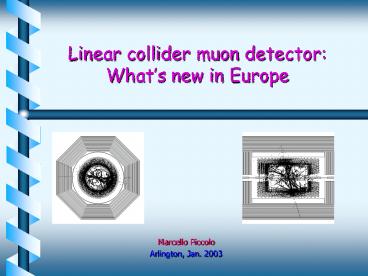Linear collider muon detector: What - PowerPoint PPT Presentation
1 / 14
Title:
Linear collider muon detector: What
Description:
tried version 3.0.6 for Brahms (thanks Ties) Debugging stage almost over ... The new Brahms release. The (Fortran) Code to ... The new Brahms release (cont. ... – PowerPoint PPT presentation
Number of Views:22
Avg rating:3.0/5.0
Title: Linear collider muon detector: What
1
Linear collider muon detector Whats new
in Europe
- Marcello Piccolo
- Arlington, Jan. 2003
2
Agenda
- ADVANCES (?)
- Mainly simulation
- tried version 3.0.6 for Brahms (thanks Ties)
- Debugging stage almost over
- Capability of writing hits files for
calorimetry and muon system - will try to integrate the two devices
- RD
- Beam time allocated at Frascati (Three weeks )
3
The new Brahms release
- The (Fortran) Code to full simulate the Tesla
detector has been upgraded - W-Si calorimeter option has been implemented
- Had Cal is based on the scintillator design.
- As of now it is possible to write a complete hit
file containing - Tracking detectors
- Calorimeters
- Muon detector
4
The new Brahms release (cont.)
- I tried to integrate a relevant number of events
in order to check performances and reproduce
previous results. - My plans were to run 10000 bb events and 10000
ZH events, but I was able to simulate about 4000
bb events and 1000 ZH events. - The complete package takes a couple of
minutes/event on a P4/1.7GHz for the entire
thing a factor 4 less if one starts from a hit
file and does only reconstruction.
5
Single positive muon efficiency
- Comparison between the old simulation (open dots)
and the new 3.0.6 one (full dots). - Some hints of non-optimized matching can be seen.
6
Energy leakage
- Here too there seem to be discrepancies between
the two releases - The newer version seems to have smaller leakage
into the muon filter. - This statement has to be taken cum grano salis,
as I did not have a chance of looking at results
in detail. - Next meeting Ill probably be able to say more on
this issue.
7
Lets now go to bb events
- Here is the overall momentum
- spectrum of the produced
- hadrons.
- It is worth noticing the relatively
- low momenta of the produced
- particles.
- The average momentum is a bit
- less than 10 GeV/c
8
Here are the overall resultsbb events _at_500 GeV
The four spectra refer to Black generated
primary particles Red generated
m Green identified m Blue misidentified p
4000 evts
9
Here are the overall resultsZH events _at_500 GeV
The four spectra refer to Black generated
primary particles Red generated
m Green identified m Blue misidentified p
1000 evts
10
Some RD points
- There are few issues that need to be addressed
- RPC (either bakelite or glass) have to be
certified as rate capable. - Gas mixes that grant to be neutron transparent,
especially for the end-caps have to be found. - Working regimes have to be investigated in
different rates environment.
11
The Frascati Test Beam Facility
12
Conceptual view of the facility
13
Particle multiplicity
14
In the coming months
- Look deeper and (hopefully) understand the
details of the new simulation tools. - Merge had-cal hits and muon hits to reduce the
muon detection threshold. - Start developing a swimming routine to follow
penetrating tracks through the different detector
subsystems. - Start the RD program on parallel plate chambers
at TBF in Frascati.































